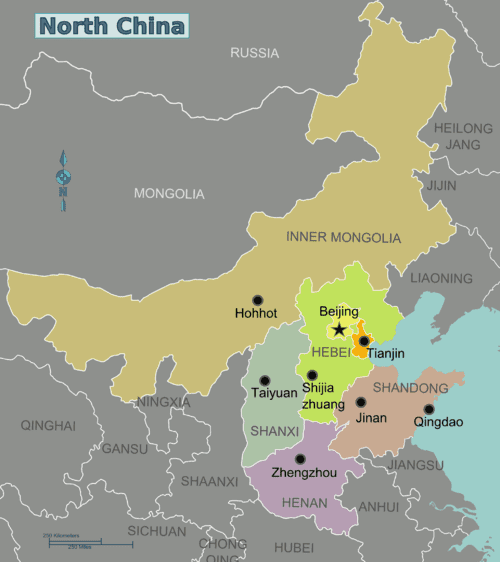We treat two adjacent areas together as the Northern Central Region of China. One is the historical heartland of the country, along the Yellow River where the Chinese Empire first developed; the other is the more wild and arid territory of Inner Mongolia to the North and West. The two are not as distinct as that makes them sound, though; Inner Mongolia now has substantial cities, and several of the other provinces have desert areas.
Regions
|
Henan Province (Birthplace of the nation and ancient home to more than 200 emperors from more than 20 dynasties)
|
|
Shanxi Province (Yellow River, mountains, ancient cities and tourist areas)
|
|
Inner Mongolia Autonomous Region
|
Cities
- Beijing — capital of the country.
- Hohhot — capital of Inner Mongolia
- Jinan — capital of Shandong Province, at the mouth of the Yellow River
- Qingdao — Shandong's largest city
- Shijiazhuang — capital of Hebei Province
- Taiyuan — industrial city with a long history, capital of Shanxi Province.
- Tianjin — port city near Beijing
- Zhengzhou — on the south bank of the Yellow River, capital of Henan Province.
Stay Safe
According to UNAIDS, 0.5% of Chinese sex workers are infected with HIV. One study reported that 5% of low-cost sex workers were infected. In one part of Yunnan province, the infection rate is estimated to be as high as 7%. The Chinese government has initiated programs to educate sex workers in HIV/AIDS prevention.
Rising HIV/AIDS rates among Chinese's elderly has been partially attributed to the use of sex workers.
China is a huge country that shows a huge regional difference in crime rates but in general it poses no more risk than most western countries. Although you may hear locals complaining about increasing crime rates, violent crime remains rare. Many tourists will more likely feel safer in China than in their home country.
|
Healthcare for foreigners
Most major Chinese cities have clinics and hospitals that are more appropriate for foreigners, with English speaking and Western qualified staff. Although expensive, it is worth identifying them whenever you plan to stay in an area for a significant time. For non-urgent medical treatment, you may want to consider traveling to Hong Kong, Taiwan or South Korea for a higher standard of treatment which may not be particularly more expensive.
|
Emergency numbers
The following emergency telephone numbers work in all areas of China; calling them from a cell phone is free.
- Patrol Police: 110
- Fire Department: 119
- (Government-owned) Ambulance/EMS: 120
- (some areas private-owned) Ambulance: 999
- Traffic Police: 122
- Directory inquiries: 114
- Consumer Protection: 12315
See Also

